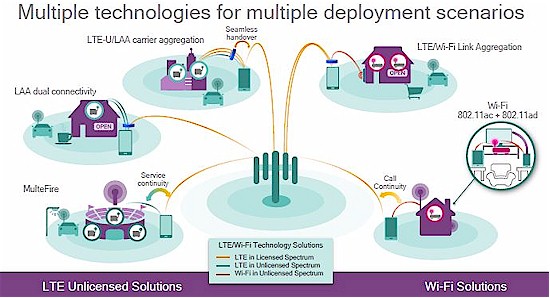
Read on SmallNetBuilder

This is only going to make it worse.
It's time to understand the impact mobile networks may have on 5 GHz Wi-Fi networks from the impending use of LTE-U / LAA.
So "Nice article", Tim, but you're wrong, eh?But this is something entirely different - once LTE gets into a UNII channel - it's going to own it - seriously - if someone is in the range of a LTE pico/femto base station operating in the same channel - you're done...
802.11 a/n/ac won't have a chance to break in to an LTE session that's already in play..
I understand the listen before talk aspects of LTE over unlicensed, but what folks are not talking about is the inverse - once LTE is there, WiFi won't transmit because the channel will be continuously busy.
So "Nice article", Tim, but you're wrong, eh?
The Wi-Fi Coexistence test specifically checks to make sure that a Wi-Fi network can be set up when LTE-U is using the channel. It also checks that LTE-U never uses more than 50% of channel capacity.
What did I miss?
I share your concern about the test plan. That's why I went through it and specifically cited what it does and doesn't do.Perhaps I was stronger in expressing my opinion, but I'm not saying anyone is "wrong"...
There are still a lot of concerns and issues with that test plan...
The information I presented said the test plan specifically checks for this. That's where you are saying what I wrote is incorrect.802.11 a/n/ac won't have a chance to break in to an LTE session that's already in play..
@sfx2000 @thiggins Please excuse my stupid question but once LTE has "camped" itself on a channel is a Wi-Fi access point even aware of its existence. Or would it simply perceive it as indeterminate background noise and transmit anyway?I understand the listen before talk aspects of LTE over unlicensed, but what folks are not talking about is the inverse - once LTE is there, WiFi won't transmit because the channel will be continuously busy.
OK thanks for the clarification, that was my suspicion.Your wifi AP and clients will not know, as they cannot decode LTE...
To WiFi clients and AP's - LTE is noise - and as a result, the noise floor jumps up, and rates go down
OK thanks for the clarification, that was my suspicion.
Then again... Say a Wi-Fi AP decides to use a channel(s) that is currently used for LTE regardless (perhaps because the owner set the AP channel manually); wouldn't the LTE's coexistence testing force it to vacate that channel? Just thinking aloud here.
Right or wrong - this is really my argument here.
As I described in the article, Wi-Fi devices can't detect LTE-U or LAA. They operate with different protocols. The equal sharing burden is on the unlicensed LTE equipment.OK thanks for the clarification, that was my suspicion.
Then again... Say a Wi-Fi AP decides to use a channel(s) that is currently used for LTE regardless (perhaps because the owner set the AP channel manually); wouldn't the LTE's coexistence testing force it to vacate that channel? Just thinking aloud here.
Anything is possible. But there will plenty of Wi-Fi companies watching and testing for this.One thing I feel will happen is, at first there will be some coexistence, but one company will break away and turn it off in order to boost performance, and then the other companies will follow in order to stay competitive.
What's worse, a neighbor running a 160 MHz bandwidth Wi-Fi network, eating up every available 5 GHz channel (DFS excluded), or LTE-U sharing one 20 MHz channel?

Welcome To SNBForums
SNBForums is a community for anyone who wants to learn about or discuss the latest in wireless routers, network storage and the ins and outs of building and maintaining a small network.
If you'd like to post a question, simply register and have at it!
While you're at it, please check out SmallNetBuilder for product reviews and our famous Router Charts, Ranker and plenty more!
